Abstract
Rat Pneumocystis carinii grown on lung-derived cell lines in tissue culture flasks and multiwell plates was tested for susceptibility to four antimicrobial agents currently being used in the treatment of human pneumocystosis. Standard criteria for organism quantitation, replication, viability, and inoculum size were established. Trimethoprim-sulfamethoxazole inhibited P. carinii growth at a concentration ratio of 1:19 microgram/ml, and pentamidine isethionate was active at 0.1 microgram/ml. alpha-Difluoromethylornithine, an inhibitor of polyamine biosynthesis, inhibited P. carinii at a concentration of 1 mM once erythrocytes (which are high in polyamine content) were removed from the inoculum; this effect could be overcome by the polyamine putrescine. Dapsone suppressed P. carinii replication at a dose of 0.1 microgram/ml, but this effect was lost after 72 h in culture. Overall, the reduction in P. carinii numbers with these drugs was relatively modest (45 to 84%), which is consistent with their lack of lethal effects on the organism in vivo. Thus, the system presented here should be helpful in developing new anti-P. carinii agents and in elucidating their mechanism of action.
Full text
PDF
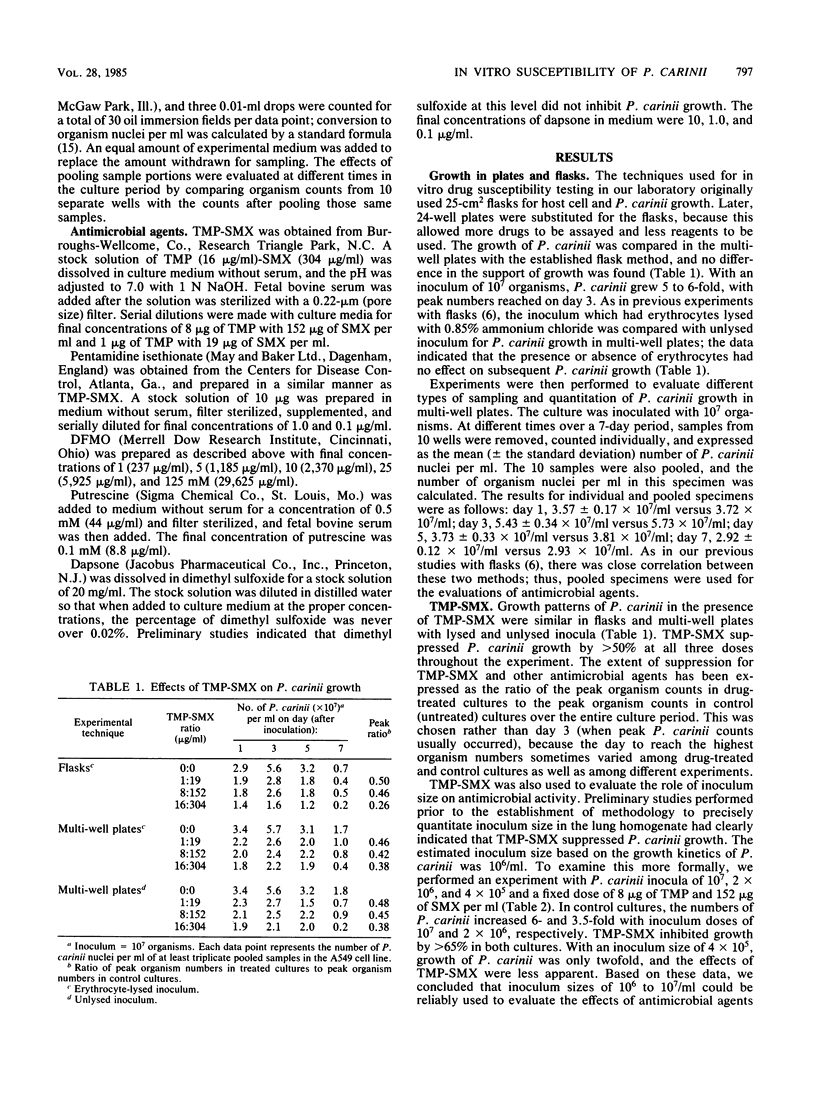
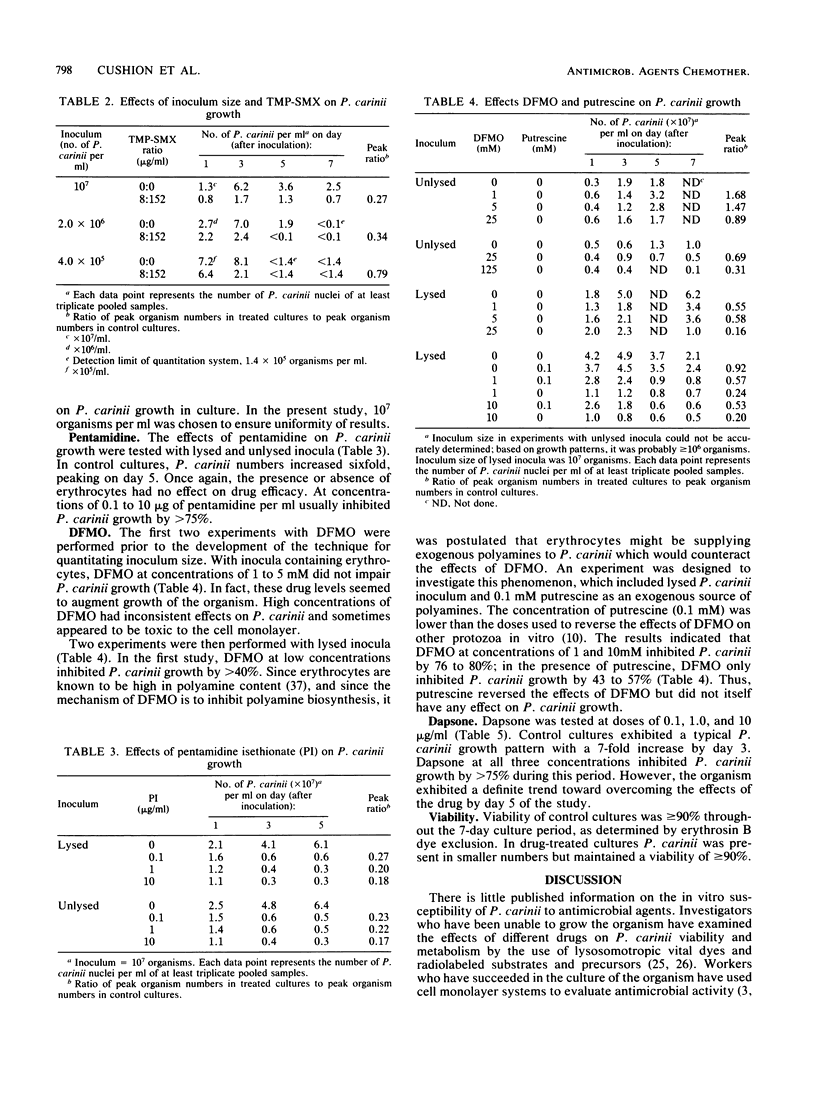
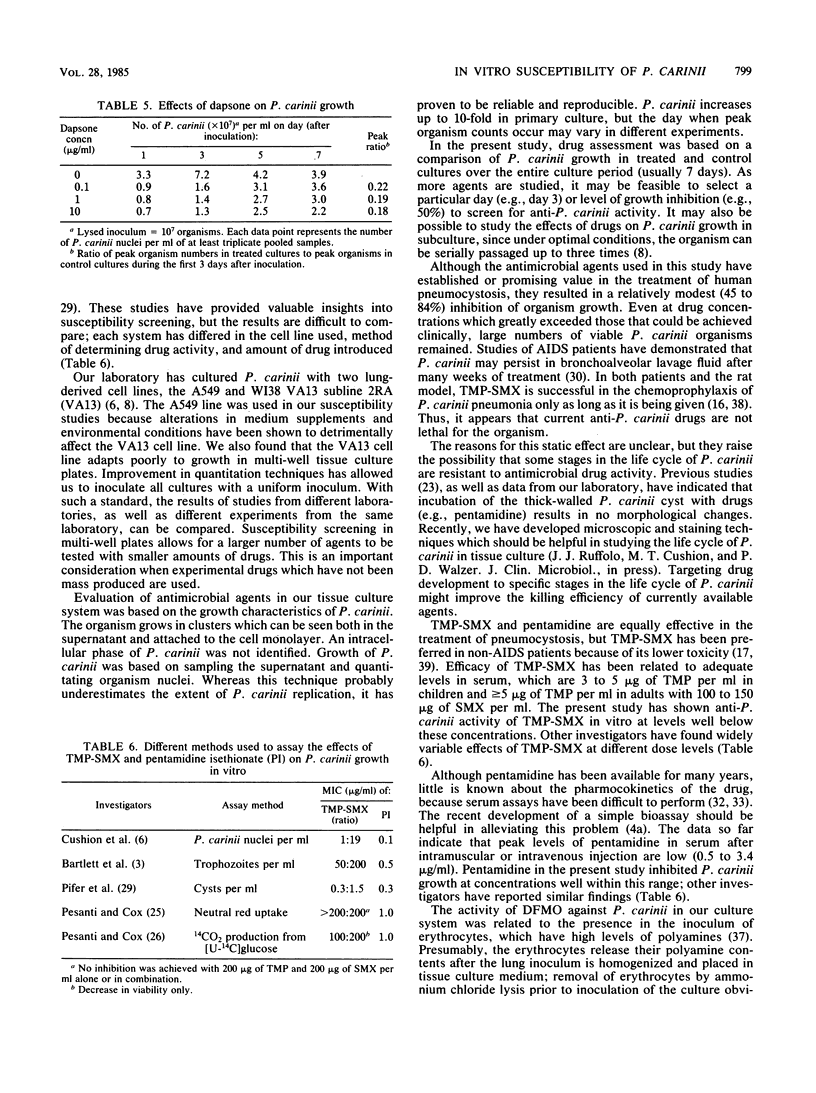
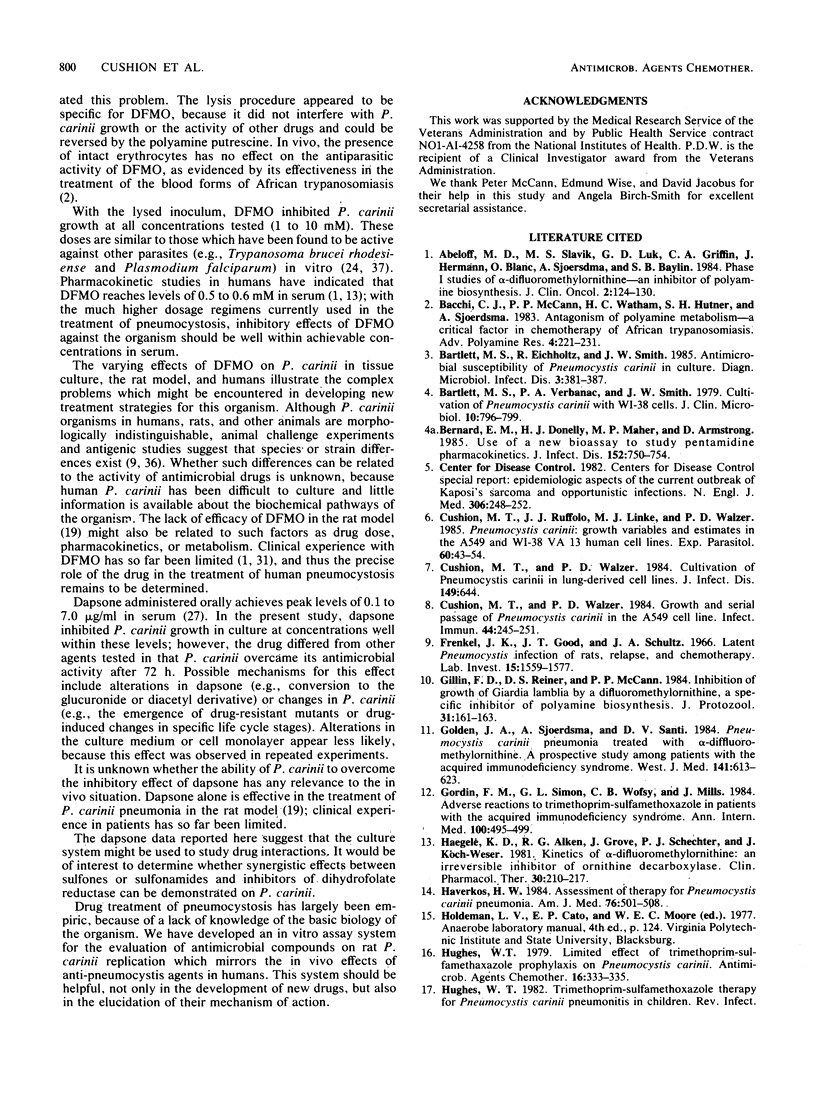
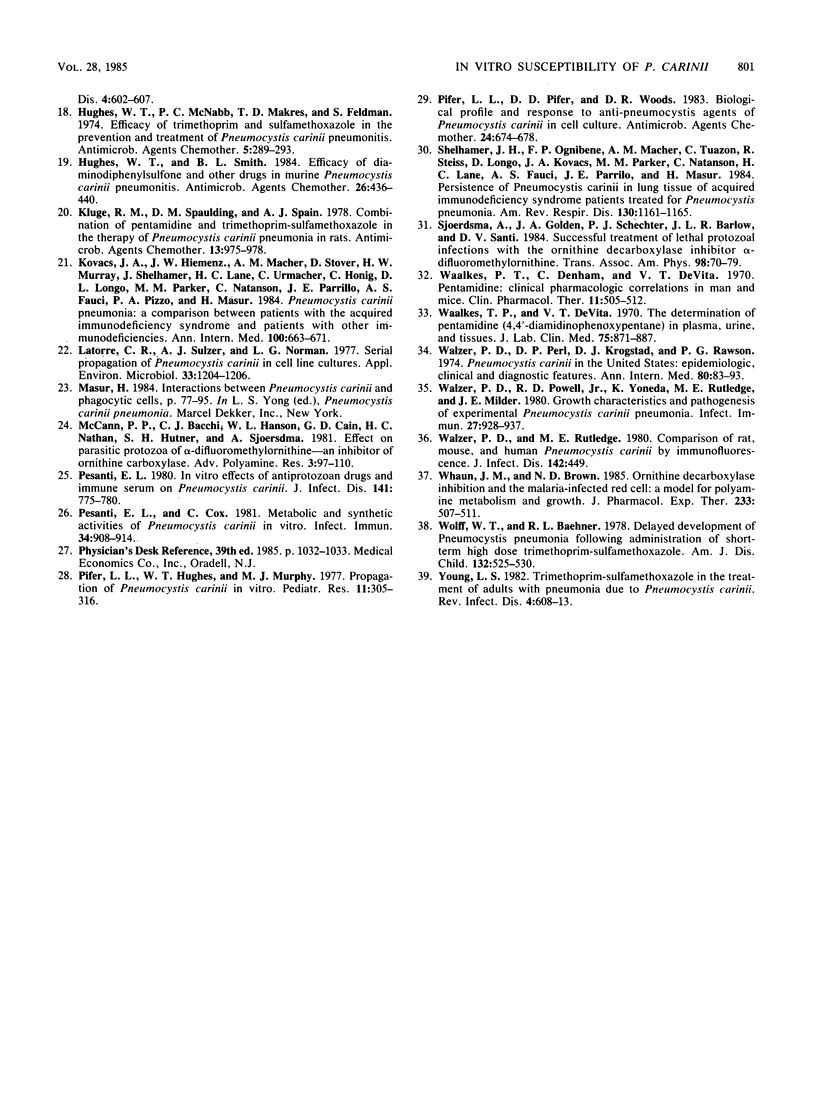
Selected References
These references are in PubMed. This may not be the complete list of references from this article.
- Abeloff M. D., Slavik M., Luk G. D., Griffin C. A., Hermann J., Blanc O., Sjoerdsma A., Baylin S. B. Phase I trial and pharmacokinetic studies of alpha-difluoromethylornithine--an inhibitor of polyamine biosynthesis. J Clin Oncol. 1984 Feb;2(2):124–130. doi: 10.1200/JCO.1984.2.2.124. [DOI] [PubMed] [Google Scholar]
- Bartlett M. S., Eichholtz R., Smith J. W. Antimicrobial susceptibility of Pneumocystis carinii in culture. Diagn Microbiol Infect Dis. 1985 Sep;3(5):381–387. doi: 10.1016/0732-8893(85)90076-8. [DOI] [PubMed] [Google Scholar]
- Bartlett M. S., Verbanac P. A., Smith J. W. Cultivation of Pneumocystis carinii with WI-38 cells. J Clin Microbiol. 1979 Dec;10(6):796–799. doi: 10.1128/jcm.10.6.796-799.1979. [DOI] [PMC free article] [PubMed] [Google Scholar]
- Bernard E. M., Donnelly H. J., Maher M. P., Armstrong D. Use of a new bioassay to study pentamidine pharmacokinetics. J Infect Dis. 1985 Oct;152(4):750–754. doi: 10.1093/infdis/152.4.750. [DOI] [PubMed] [Google Scholar]
- Cushion M. T., Ruffolo J. J., Linke M. J., Walzer P. D. Pneumocystis carinii: growth variables and estimates in the A549 and WI-38 VA13 human cell lines. Exp Parasitol. 1985 Aug;60(1):43–54. doi: 10.1016/s0014-4894(85)80021-7. [DOI] [PubMed] [Google Scholar]
- Cushion M. T., Walzer P. D. Cultivation of Pneumocystis carinii in lung-derived cell lines. J Infect Dis. 1984 Apr;149(4):644–644. doi: 10.1093/infdis/149.4.644. [DOI] [PubMed] [Google Scholar]
- Cushion M. T., Walzer P. D. Growth and serial passage of Pneumocystis carinii in the A549 cell line. Infect Immun. 1984 May;44(2):245–251. doi: 10.1128/iai.44.2.245-251.1984. [DOI] [PMC free article] [PubMed] [Google Scholar]
- Frenkel J. K., Good J. T., Shultz J. A. Latent Pneumocystis infection of rats, relapse, and chemotherapy. Lab Invest. 1966 Oct;15(10):1559–1577. [PubMed] [Google Scholar]
- Gillin F. D., Reiner D. S., McCann P. P. Inhibition of growth of Giardia lamblia by difluoromethylornithine, a specific inhibitor of polyamine biosynthesis. J Protozool. 1984 Feb;31(1):161–163. doi: 10.1111/j.1550-7408.1984.tb04308.x. [DOI] [PubMed] [Google Scholar]
- Golden J. A., Sjoerdsma A., Santi D. V. Pneumocystis carinii pneumonia treated with alpha-difluoromethylornithine. A prospective study among patients with the acquired immunodeficiency syndrome. West J Med. 1984 Nov;141(5):613–623. [PMC free article] [PubMed] [Google Scholar]
- Gordin F. M., Simon G. L., Wofsy C. B., Mills J. Adverse reactions to trimethoprim-sulfamethoxazole in patients with the acquired immunodeficiency syndrome. Ann Intern Med. 1984 Apr;100(4):495–499. doi: 10.7326/0003-4819-100-4-495. [DOI] [PubMed] [Google Scholar]
- Haegele K. D., Alken R. G., Grove J., Schechter P. J., Koch-Weser J. Kinetics of alpha-difluoromethylornithine: an irreversible inhibitor of ornithine decarboxylase. Clin Pharmacol Ther. 1981 Aug;30(2):210–217. doi: 10.1038/clpt.1981.150. [DOI] [PubMed] [Google Scholar]
- Haverkos H. W. Assessment of therapy for pneumocystis carinii pneumonia. PCP Therapy Project Group. Am J Med. 1984 Mar;76(3):501–508. doi: 10.1016/0002-9343(84)90670-3. [DOI] [PubMed] [Google Scholar]
- Hughes W. T. Limited effect of trimethoprim-sulfamethoxazole prophylaxis on Pneumocystis carinii. Antimicrob Agents Chemother. 1979 Sep;16(3):333–335. doi: 10.1128/aac.16.3.333. [DOI] [PMC free article] [PubMed] [Google Scholar]
- Hughes W. T., McNabb P. C., Makres T. D., Feldman S. Efficacy of trimethoprim and sulfamethoxazole in the prevention and treatment of Pneumocystis carinii pneumonitis. Antimicrob Agents Chemother. 1974 Mar;5(3):289–293. doi: 10.1128/aac.5.3.289. [DOI] [PMC free article] [PubMed] [Google Scholar]
- Hughes W. T., Smith B. L. Efficacy of diaminodiphenylsulfone and other drugs in murine Pneumocystis carinii pneumonitis. Antimicrob Agents Chemother. 1984 Oct;26(4):436–440. doi: 10.1128/aac.26.4.436. [DOI] [PMC free article] [PubMed] [Google Scholar]
- Kluge R. M., Spaulding D. M., Spain A. J. Combination of pentamidine and trimethoprim-sulfamethoxazole in therapy of Pneumocystis carinii pneumonia in rats. Antimicrob Agents Chemother. 1978 Jun;13(6):975–978. doi: 10.1128/aac.13.6.975. [DOI] [PMC free article] [PubMed] [Google Scholar]
- Kovacs J. A., Hiemenz J. W., Macher A. M., Stover D., Murray H. W., Shelhamer J., Lane H. C., Urmacher C., Honig C., Longo D. L. Pneumocystis carinii pneumonia: a comparison between patients with the acquired immunodeficiency syndrome and patients with other immunodeficiencies. Ann Intern Med. 1984 May;100(5):663–671. doi: 10.7326/0003-4819-100-5-663. [DOI] [PubMed] [Google Scholar]
- Latorre C. R., Sulzer A. J., Norman L. G. Serial propagation of Pneumocystis carinii in cell line cultures. Appl Environ Microbiol. 1977 May;33(5):1204–1206. doi: 10.1128/aem.33.5.1204-1206.1977. [DOI] [PMC free article] [PubMed] [Google Scholar]
- Pesanti E. L., Cox C. Metabolic and synthetic activities of Pneumocystis carinii in vitro. Infect Immun. 1981 Dec;34(3):908–914. doi: 10.1128/iai.34.3.908-914.1981. [DOI] [PMC free article] [PubMed] [Google Scholar]
- Pesanti E. L. In vitro effects of antiprotozoan drugs and immune serum on Pneumocystis carinii. J Infect Dis. 1980 Jun;141(6):775–780. doi: 10.1093/infdis/141.6.775. [DOI] [PubMed] [Google Scholar]
- Pifer L. L., Hughes W. T., Murphy M. J., Jr Propagation of Pneumocystis carinii in vitro. Pediatr Res. 1977 Apr;11(4):305–316. doi: 10.1203/00006450-197704000-00010. [DOI] [PubMed] [Google Scholar]
- Pifer L. L., Pifer D. D., Woods D. R. Biological profile and response to anti-pneumocystis agents of Pneumocystis carinii in cell culture. Antimicrob Agents Chemother. 1983 Nov;24(5):674–678. doi: 10.1128/aac.24.5.674. [DOI] [PMC free article] [PubMed] [Google Scholar]
- Shelhamer J. H., Ognibene F. P., Macher A. M., Tuazon C., Steiss R., Longo D., Kovacs J. A., Parker M. M., Natanson C., Lane H. C. Persistence of Pneumocystis carinii in lung tissue of acquired immunodeficiency syndrome patients treated for pneumocystis pneumonia. Am Rev Respir Dis. 1984 Dec;130(6):1161–1165. doi: 10.1164/arrd.1984.130.6.1161. [DOI] [PubMed] [Google Scholar]
- Sjoerdsma A., Golden J. A., Schechter P. J., Barlow J. L., Santi D. V. Successful treatment of lethal protozoal infections with the ornithine decarboxylase inhibitor, alpha-difluoromethylornithine. Trans Assoc Am Physicians. 1984;97:70–79. [PubMed] [Google Scholar]
- Waalkes T. P., DeVita V. T. he determination of pentamidine (4,4'-diamidinophenoxypentane) in plasma, urine, and tissues. J Lab Clin Med. 1970 May;75(5):871–878. [PubMed] [Google Scholar]
- Waalkes T. P., Denham C., DeVita V. T. Pentamidine: clinical pharmacologic correlations in man and mice. Clin Pharmacol Ther. 1970 Jul-Aug;11(4):505–512. doi: 10.1002/cpt1970114505. [DOI] [PubMed] [Google Scholar]
- Walzer P. D., Perl D. P., Krogstad D. J., Rawson P. G., Schultz M. G. Pneumocystis carinii pneumonia in the United States. Epidemiologic, diagnostic, and clinical features. Ann Intern Med. 1974 Jan;80(1):83–93. doi: 10.7326/0003-4819-80-1-83. [DOI] [PubMed] [Google Scholar]
- Walzer P. D., Powell R. D., Jr, Yoneda K., Rutledge M. E., Milder J. E. Growth characteristics and pathogenesis of experimental Pneumocystis carinii pneumonia. Infect Immun. 1980 Mar;27(3):928–937. doi: 10.1128/iai.27.3.928-937.1980. [DOI] [PMC free article] [PubMed] [Google Scholar]
- Walzer P. D., Rutledge M. E. Comparison of rat, mouse, and human Pneumocystis carinii by immunofluorescence. J Infect Dis. 1980 Sep;142(3):449–449. doi: 10.1093/infdis/142.3.449. [DOI] [PubMed] [Google Scholar]
- Whaun J. M., Brown N. D. Ornithine decarboxylase inhibition and the malaria-infected red cell: a model for polyamine metabolism and growth. J Pharmacol Exp Ther. 1985 May;233(2):507–511. [PubMed] [Google Scholar]
- Wolff L. J., Baehner R. L. Delayed development of pneumocystis pneumonia following administration of short-term high-dose trimethoprim-sulfamethoxazole. Am J Dis Child. 1978 May;132(5):525–526. doi: 10.1001/archpedi.1978.02120300085018. [DOI] [PubMed] [Google Scholar]
- Young L. S. Trimethoprim-sulfamethoxazole in the treatment of adults with pneumonia due to Pneumocystis carinii. Rev Infect Dis. 1982 Mar-Apr;4(2):608–613. doi: 10.1093/clinids/4.2.608. [DOI] [PubMed] [Google Scholar]


